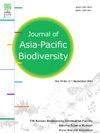First record of the genus Alluaudomyia (Diptera: Ceratopogonidae) with five species in the Republic of Korea
IF 0.7
Q4 BIODIVERSITY CONSERVATION
引用次数: 0
Abstract
The genus Alluaudomyia Kieffer, 1913 (Diptera: Ceratopogonidae) represents a diverse group of predaceous midges for their small size, pale coloration, and characteristic dark spot patterns on their wings, with a global distribution and 206 species documented to date. This study presents the first record of five Alluaudomyia species in the Korean Peninsula with a taxonomic key for these species and provides DNA barcoding data with COI region. Specimens were collected over a two-year period from the Republic of Korea using black light traps. The newly identified species were A. lucania Lee and Yu, 1997, A. quinquepicina Yu and Zhang, 2005, A. signosoma Yu and Zhang, 2005, A. tiberghieni Neveu, 1978, and A. tripartita Okada, 1942. These findings provide a foundation for further taxonomic studies and biodiversity assessments of Ceratopogonidae in Korea.
文章标题韩国首次记录蠓属5种(双翅目:蠓科)
Alluaudomyia Kieffer属,1913(双翅目:蠓科)代表了一种不同的食肉蠓,它们体型小,颜色浅,翅膀上有典型的暗斑图案,分布在全球,迄今为止记录了206种。本研究首次在朝鲜半岛记录了5个Alluaudomyia种,并对其进行了分类检索,并提供了COI区DNA条形码数据。在两年的时间里,使用黑光诱捕器在大韩民国收集了标本。新鉴定种为A. lucania Lee and Yu(1997)、A. quinquepicina Yu and Zhang(2005)、A. signoma Yu and Zhang(2005)、A. tiberghieni Neveu(1978)和A. tripartita Okada(1942)。这些发现为进一步开展韩国蠓科的分类研究和生物多样性评价奠定了基础。
本文章由计算机程序翻译,如有差异,请以英文原文为准。
求助全文
约1分钟内获得全文
求助全文
来源期刊

Journal of Asia-Pacific Biodiversity
Agricultural and Biological Sciences-Insect Science
CiteScore
1.70
自引率
12.50%
发文量
94
审稿时长
27 days
期刊介绍:
The Journal of Asia-Pacific Biodiversity (previous title was Journal of Korean Nature) is an official journal of National Science Museum of Korea (NSMK) and Korea National Arboretum (KNA). The scope of journal is wide and multidisciplinary that publishes original research papers, review articles, as well as conceptual, technical and methodological papers on all aspects of biological diversity-its description, analysis and conservation, and its application by humankind. This wide and multidisciplinary journal aims to provide both scientists and practitioners in conservation theory, policy and management with comprehensive and applicable information. However, papers should not be submitted that deal with microorganisms, except in invited paper. Articles that are focused on the social and economical aspects of biodiversity will be normally not accepted.
 求助内容:
求助内容: 应助结果提醒方式:
应助结果提醒方式:


